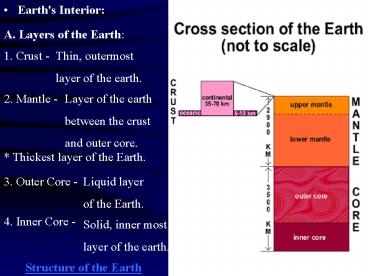Earth's Interior: - PowerPoint PPT Presentation
Title:
Earth's Interior:
Description:
Earth's Interior: A. Layers of the Earth: 1. Crust - Thin, outermost layer of the earth. 2. Mantle - Layer of the earth between the crust and outer core. – PowerPoint PPT presentation
Number of Views:344
Avg rating:3.0/5.0
Title: Earth's Interior:
1
- Earth's Interior
A. Layers of the Earth
1. Crust -
Thin, outermost layer of the earth.
2. Mantle -
Layer of the earth between the crust and outer
core.
Thickest layer of the Earth.
3. Outer Core -
Liquid layer of the Earth.
4. Inner Core -
Solid, inner most layer of the earth.
Structure of the Earth
2
The crust and upper mantle together are called
the lithosphere. The lower mantle is called the
asthenosphere.
Lithostone
Athenosweak
3
- What is the Mohorovicic Discontinuity?
- -The "Moho", is the boundary between the crust
and the mantle. The red line in the drawing below
shows its location.
Why "discontinuity?
It is used for a surface at which seismic waves
change velocity. At this discontinuity, seismic
waves accelerate.
Seismic waves- are waves that travel through the
Earth, most often as the result of a tectonic
earthquake, sometimes from an explosion.
4
How Was the Moho Discovered?
- The Mohorovicic Discontinuity was discovered in
1909 by Andrija Mohorovicic , a Croatian
seismologist, after the Pokuplje (Kupa Valley)
earthquake of 8 Oct 1909. He realized that the
velocity of a seismic wave is related to the
density of the material that it is moving
through. He interpreted the acceleration of
seismic waves observed within Earth's outer shell
as a compositional change within the earth. The
acceleration was caused by the waves moving
through a higher density material at that
depth.
5
How Deep is the Moho?
- The Mohorovicic Discontinuity marks the lower
limit of Earth's crust.
average depth 8 kilometers beneath the ocean
basin average depth 32 kilometers beneath the
continents.
??WHY THE DIFFERENCE??
Oceanic crust has a relatively uniform thickness
while continental crust is thickest under
mountain ranges and thinner under plains.
6
- The map illustrates the thickness of Earth's
crust. Note how the thickest areas (red and dark
brown) are beneath some of Earth's important
mountain ranges such as Andes (west side of
South America), Rockies (Western North America),
Himalayas (north of India in South-central Asia)
and Urals (north-south trending between Europe
and Asia)
7
Has Anyone Ever Seen the Moho?
- No one has ever been deep enough into the earth
to see the Moho and no wells have ever been
drilled deep enough to penetrate it. Drilling
wells to that depth is very expensive and very
difficult because of the extreme temperature and
pressure conditions. The deepest well that has
been drilled to date was located on the Kola
Peninsula of the Soviet Union. It was drilled to
a depth of about 12 kilometers (7.6 miles).
Current deep drilling projects include The San
Andreas Scientific Drilling Project in Parkfield
CA (2.5 mi) The Hawaii Scientific Drilling
Project on Hilo, Hawaii (1.8 mi) Chesapeake Bay
(1.1 mile bore hole into an impact crater)
Integrated Ocean Drilling Project in the
Atlantic Ocean (.9mi) Read More about drilling
projects going on around the world.
8
- There are a few rare locations where mantle
material has been brought to the surface by
tectonic forces. At these locations, that used to
be at the crust - mantle boundary is present. A
photo of rock from one of these locations is
shown below.
9
(No Transcript)































